There is no overstating the importance of timing. It can be the difference between meeting your future spouse and just missing the taxi cab, or it can separate a well-executed strike from a mistake pitch that is deposited into the bleachers. Timing is the most critical variable in the pitching equation, particularly as it pertains to the sequencing of events within the kinetic chain. Gameday performance is heavily influenced by a pitcher's ability to harness his timing and sequencing, factors that determine the command, velocity, and movement on his pitches.
Of all the grades on the mechanics report card, the score for repetition is not only the most difficult to evaluate—since hundredths of a second can separate the haves from the have-nots—but it is also the most volatile element during the season. Case in point, a number of pitchers that were covered by Raising Aces in the spring have since experienced large changes to their timing patterns, adjustments that could alter their individual outlooks for performance down the stretch.
Yu Darvish
My first player breakdown for BP covered the major-league debut of Yu Darvish, whose mysterious repertoire had helped fuel a media frenzy during the first week of the regular season. I focused on Darvish's issues with mechanical timing, as his struggles with repetition resulted in high pitch counts and some crooked numbers on the scoreboard in that first start, factors that belied the positive aspects of his mechanics. My assessment was that he was probably just shaking off the rust, a common scenario in the early weeks of the season, and that he was likely dealing with nerves that come with $100 million expectations. His mechanical profile was otherwise exceptional, an encouraging sign of greater things to come.
Darvish took longer than expected to find his time signature, displaying inconsistency throughout the summer that limited the utility of his explosive stuff, piling up strikeouts and walks by the truckload. He also toyed with his mechanics, at one point introducing a distinct pause in his motion as he reached maximum leg lift, a technique that is popular in Japan and that has been popularized stateside by Daisuke Matsuzaka, but the strategy only exacerbated the timing issues by opening the window for error while halting his progression.
Darvish wisely ditched the stutter-stop after his start on August 6th, and after another disaster outing on August 12th, the right-hander re-discovered his fluid timing. The pitcher who walked more than four batters per game in July and early August has allowed just four total free passes against 26 punchouts in his past 21 innings. He has done a much better job of repeating the delivery overall, but Darvish still takes awhile to find his timing in-game. To quote Rangers team President and former ace Nolan Ryan, “I've seen him struggle in some early innings before falling into a rhythm.”
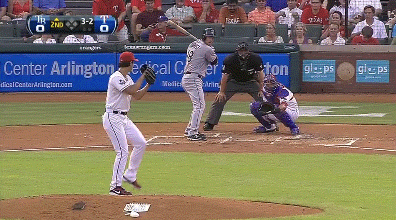
Such was the story in the August 28th contest against the Rays. Darvish's release point was all over the place for the first two innings, with frequent bouts of under-rotation that included the above walk to Ben Zobrist. Darvish appeared to be clearly out of sync, adjusting his shoulders between pitches to loosen up the joints.
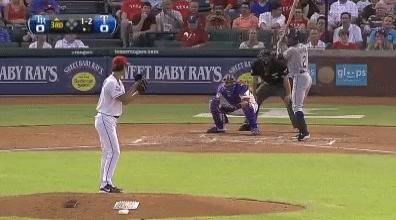
Something must have clicked between innings, because Darvish was lining up his delivery throughout the third, including the perfectly-tuned laser that melted B.J. Upton for the backwards K. Darvish kept his consistency throughout the rest of the game, including a troublesome fourth frame that was merely a case of outcomes not matching up with the efficiency of his process. The underlying stuff and mechanical baselines for Darvish are off the chart, but his ultimate ceiling will be dictated by his ability to become the master of his own timing domain.
***
Tim Lincecum
Lincecum, the ace of the Giants’ staff for the past five years, is another case where I anticipated greater times ahead, only to sit in the waiting room for a player with ace stuff and extreme mechanics to reclaim his own delivery. Much like Darvish, the diagnosis for Lincecum centers around his lack of pitch command, the root of which is mechanical timing. Darvish and Lincecum both rely on exceptional momentum as part of their ideal time signatures, but Lincecum's prognosis is more closely linked to the level of conditioning involved with such a high-octane delivery. Both pitchers are a step away from utter dominance due to incredible stuff that they cannot locate consistently.
Functional strength and flexibility have always been a relevant topic with Lincecum, given the Freak's slight frame and ultra-aggressive pitching motion. His spine curves like a question mark near release point, demonstrating a strength deficiency that gets worse as the right-hander becomes fatigued, while his leaping stride requires tremendous lower-body strength to execute repeatedly. The conditioning issue reared its ugly head back in 2010, when Lincecum wore down during a brutal August as the Giants were making their playoff push.
Lincecum has slowly worked his way back into the fantasy circle of trust, and though occasional mechanical flare-ups have obscured the improvement, his overall numbers since the All-Star break resemble those of vintage Timmy. Lincecum showed glimpses of his former self in the April 23 game, and though his comeback has been slower than anticipated, his season-long progression points to conditioning factors that are a key determinant of success for a pitcher with a high-maintenance delivery and a sensitive timing pattern.
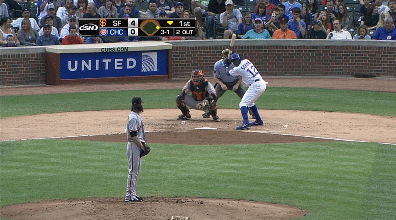
Granted, a hacker like Alfonso Soriano is probably the most favorable matchup for a pitcher of Lincecum's profile, but the pitches are impressive nonetheless. The strike-two fastball is well-timed and traces a direct path to Hector Sanchez's catcher's mitt, with enough velocity to trigger a late swing from Soriano. Suffice to say that Sanchez was intimidated, shuddering away from the powerful winds generated by the whiff of the Cubbie outfielder. Strike three was even more impressive, freezing Soriano with another painted target, this time on a heater to the inside edge of the zone that sent everyone to their respected dugouts.
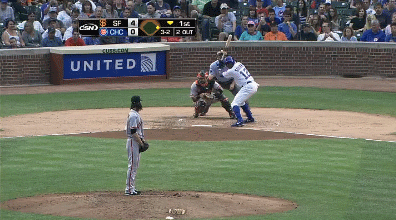
***
Ubaldo Jimenez
When we last checked in with Jimenez, we put his mechanical adjustments under the microscope in order to understand what was amiss for a player who had dropped four miles per hour off his fastball while losing any semblance of pitch command. His maladies were identified as postural instability in addition to the thematic issues with timing and repetition, elements that combined to push his below-average walk rates to unacceptable levels.
On the bright side, Jimenez has successfully trimmed his walk rate over the last few weeks, though such stats are hardly an endorsement of his pitch command. He has traded the walks for hard-hit baseballs, as missed targets are catching large swaths of home plate rather than staying out of bat's reach. Jimenez has coughed up five or more earnies in five of his 11 starts since the All-Star break, a stretch in which he has allowed six or more hits in every outing.
Jimenez still has the graphic spine-tilt and the saloon-door landing leg, his balance is still a mess throughout the delivery, and he still has the weird timing-hitch just before he triggers trunk rotation. It is rare to witness two consecutive deliveries from Jimenez with similar timing, sequencing, or positioning. The statistical trends underscore the functional differences between pitch command and control, as Ubaldo's sudden strike-throwing ability is littered with pitches that miss within the zone.
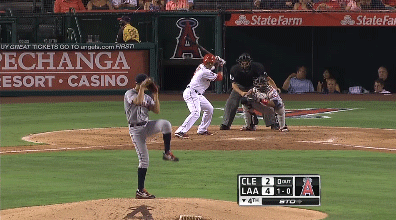
The home run that Jimenez served up to Erick Aybar is a prime example of this phenomenon. Catcher Carlos Santana set up a target on the lower edge of the strike zone, but Jimenez missed his location by a good six inches and left the pitch right over the plate. Not even the mighty Coors Field should turn a slap-hitter like Aybar into a source of power, but Ubaldo left the baseball in a suicide location for major-league bats.
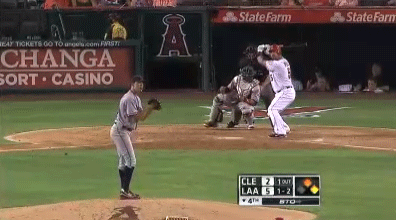
Jimenez still misses wide of the zone on plenty of occasions, such as the wayward pitch above to Albert Pujols. The pitch was one of Jimenez's league-leading 15 wild ones, and Pujols would deposit the very next offering deep into the left-field seats, scooping the pitch off the ground as a warning to all those who attempt to avoid his lumber.
***
Stephen Strasburg
Right now, the biggest story in Washington is not Barack Obama or Mitt Romney, but the proposed innings threshold of Nationals pitcher Stephen Strasburg. The fates have placed an injury-scarred wunderkind in the path of the organization's first playoff appearance since leaving the Great White North and second in franchise history. The situation has been widely discussed across the interwebs, beginning with the April surge that saw the Nats jump ahead of the NL East and prompting a cautionary conclusion in my own evaluation of Stras last May.
On the one hand, you have an organization that is sitting in the middle of our nation's capitol, at a time of maximum national exposure thanks to the upcoming presidential election, in its first legitimate opportunity to convert a championship season into a long-term fan base. On the other hand, you have the greatest pitching prospect of all time, one whose previous trip under the knife still burns in the memories of baseball fans across the country, a pitcher whose career could hang in the balance as risks are taken in the quest for the ultimate trophy.
The Nats are in a classic lose-lose situation: if they keep Stras in play but fall short of a deep playoff run, then the right-hander's future will be tinged with paranoia due to the potential injury repercussions of the decision. If the team shuts Strasburg down and then fails to advance to the World Series, then fans might forever be sour over the championship opportunity that may have been squandered. The only PR victory for the Washington baseball club is a quixotic scenario where A) they shut Stras down and win it all regardless, or B) they keep him pitching and he stays completely healthy for the next four years of his contract.
With Operation Stras-down lurking on the horizon, everyone is coming out of the woodwork to weigh in with their opinions, and it should come as no surprise that this man's opinion is mechanically-influenced. The recovery process from major arm surgery is tumultuous and unpredictable, and though modern medicine has greatly improved the prognosis for UCL casualties such as Strasburg, the fact remains that his body is still adjusting to the demands of throwing 100-mph pitches with a new ligament. The kinetic toll that Strasburg accrues with his torque-heavy delivery is greater than that of a pitcher with less impressive radar-gun readings, increasing the strain on his recovering limb as he ventures into uncharted territory with respect to workload. This is also a pitcher whose mechanical profile contains known pre-cursors to injury, with the greatest danger coming from the potential for elbow-drag during the rotational phases of the delivery. Pitchers with poor timing run the risk of elbow-drag through an excessive delay of trunk rotation, and those such as Strasburg who have an extreme scapular load are more prone to damage. Making matters worse is the general tendency for elbow-drag to occur as pitchers become tired and timing falls out of whack, and a recovering pitcher at the end of his longest season is at the top of the list for fatigue-related injury risk.
The Nats appear to be stuck with a choice between unfavorable options, but the bigger question is why they’ve chosen to force themselves into such a no-win position, especially given ample time to formulate an alternative plan. Washington has had a commanding lead in the NL East since early June, and such a gap should have granted enough leeway to structure Strasburg's workload in order to maximize his longevity. The team has done a great job of limiting his pitch-counts per game, having exceeding 100 pitches just ten times and passing the 110 threshold only twice, so they have certainly managed the in-game fatigue for their prized arm. But could they have done more?
The Nats could have skipped every fifth start and left it as a bullpen day, a strategy that would have trimmed more than 30 innings off of his total for this year and provided enough buffer to carry their ace through the postseason, all while maintaining his regular throwing routine. But to throw caution to the wind at this juncture is to ignore the realities of Tommy John surgery; to quote Dr. James Andrews, a man who knows a thing or three about the operation: "The re-injury rate is highest in the second year… So standard procedure is to watch the fatigue factor the first year back [pitching]."
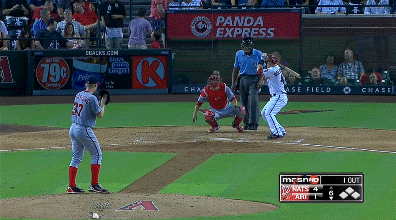
I have been asked whether there have been any obvious signs of fatigue as Stras progressed through the season, and though he has had occasional battles with timing and pitch command (above), he has still shown the ability to freeze batters like Justin Upton with some perfectly-timed mechanics and killer stuff.

Strasburg's fastball velocity in August was about one-and-a-half ticks below his spring velo, and back-to-back four-walk outings effectively stirred the pot with doubt, only to be silenced by his utter domination of the Braves in his following start that was vintage Stras. Greater concern stems from the occurrence of individual pitches that are badly mistimed, and the three videos represent three pitches in the span of two batters that hit all the notes of over-rotation (top), ideal timing (middle), and most dangerous to Stras, under-rotated fastballs, which carry the greatest risk of elbow-drag (below).
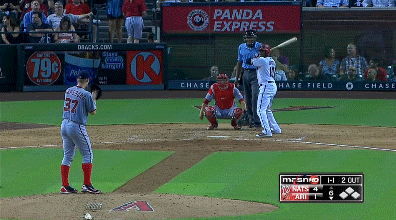
***
James McDonald
I was amazed at McDonald's profile when I studied his delivery back in May. His mechanics report card left much to be desired, with late spine-tilt and poor momentum contributing to much of the criticism, but I was shocked that McDonald was able to repeat his delivery despite the mechanical obstacles. Such a description drove me to predict some heavy correction to his stat line, as he just did not have the mechanical underpinnings of a shutdown starter. I didn't need my old stats professor to tell me that his 2.20 ERA and 3.3:1 K-to-walk ratio were due for regression, but McDonald continued to defy the laws of tradition while making me look bad with another five weeks of dominance before the wheels fell off the wagon.
McDonald's season reached a turning point in Colorado on Friday, July 13th. It was his first start back from the All-Star break, a game in which McDonald fell behind 3-0 before he recorded a single out against the Rockies. The red-hot Dexter Fowler led off with a blast to center field on a quality fastball that was well-executed, but the rattled McDonald walked the next batter, Marco Scutaro, on four consecutive pitches as his timing fell off track. The final pitch to Scutaro was severely under-rotated, as the pitcher's rotation was triggered too late in the sequence (relative to foot strike), and the arm couldn't catch up to the rest of the delivery.
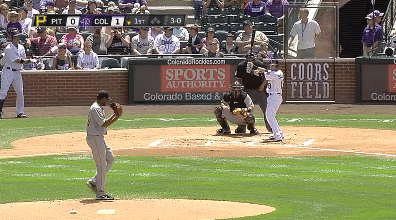
Similar to the case of Ubaldo Jimenez, McDonald's struggles have been tied to pitches that miss targets within the strike zone as much as those that lead to walks, the result of which has been a blow-up of epic proportions. Carlos Gonzalez put an exclamation point on the afternoon when a McDonald fastball missed high on a low target, and CarGo used pure bat-speed to pull the outside pitch out of the yard.

Prior to the break, McDonald had given up three or more earned runs just four times in seventeen starts, never having allowed more than four runs in a game. Then he went on a post-break run of six straight starts of giving up at least four tallies per game, all but one of which cracked the five-run barrier. Sunday's eight-run disaster against Milwaukee lasted less than three innings, and the four homers that McDonald allowed were more than he had given up in the entire month of August. The Brewer-bashing was the final straw for many fantasy players, judging by McDonald's presence on Yahoo's “most dropped players” list.
Thank you for reading
This is a free article. If you enjoyed it, consider subscribing to Baseball Prospectus. Subscriptions support ongoing public baseball research and analysis in an increasingly proprietary environment.
Subscribe now
The strategy could certainly help with his timing, as pitching from the stretch all the time means that he only needs to master one timing pattern, as opposed to disparate timing from windup and stretch. When working with younger players, I often encourage them to pitch exclusively from the stretch in order to simplify their mechanics.
Between the stretch adjustment and the pause in his momentum that was introduced over the summer, Darvish has made some pretty big mechanical adjustments in-season.
Watching him pitch, I rarely get the impression that he is comfortable on the mound or pleased with his results, leaving me fascinated by what we might see in the postseason if he finds his mechanical groove.
I think I hear a project for the off-season ...
The Nats have another pitcher in Zimmerman that's in his second year post TJ that looks fatigued and probably shouldn't go over 185 innings this year yet there is no talk about shutting him down. Can you do a breakdown on him?
Any advice for a little-league coach trying to learn more about basic pitching mechanics? Is there a particular book or video you'd recommend?
And if you pardon my shameless plug, I recommend the book that I co-wrote with House - "Arm Action" - to anyone who is interested in numbers that challenge the conventional wisdom of pitching.
I wasn't in a good position to watch Friday night when Timmy walked seven. See anything of note?